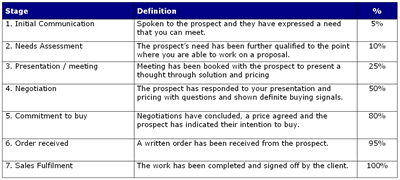Sales pipeline management requires employees to understand the process, be held accountable and to take activity. The results must be measured so a reporting process needs to be agreed.
I have worked through the process with a number of clients this month. It is a 6 stage process:
- List the major stages that you go through when working with a sales opportunity. These should not be too detailed. For example:
1. Initial Communication
2. Needs Assessment
3. Presentation / meeting
4. Negotiation
5. Commitment to buy
6. Order received
7. Sales Fulfilment - Define what you mean by each stage. It is essential that all of your team understand how to classify an opportunity. For example, what has to happen when you first talk to a prospect to qualify for the 'Initial communication' stage? What has to happen for an order to be classified as 'Order Received' - verbal order or PO Number?
- Attach a probability to each stage. You are trying to understand what the probability is of closing a deal at any stage. For example, you might say that 10% of new opportunities turn into orders. Or that 95% of opportunities where you get a commitment to buy actually turn into an order. This is the place where you don't want to worry too much about being spot on - all you are looking for is an an approximation.
- Introduce a system to manage this whole process. There a many CRM systems that can do this for you but working on a tight budget one of the best is Sage ACT!
- Keep the results updated. A sales pipeline will only be useful if you keep it up-to-date and regularly reviewed.
- Refine the process. You will need to give the process some time to settle down but after a while you will want to refine the process.
You should end up with a table like this:

If you follow these steps you will have a measurable way of tracking opportunity progress and one measure for assessing the competency of your sales people.
No comments:
Post a Comment